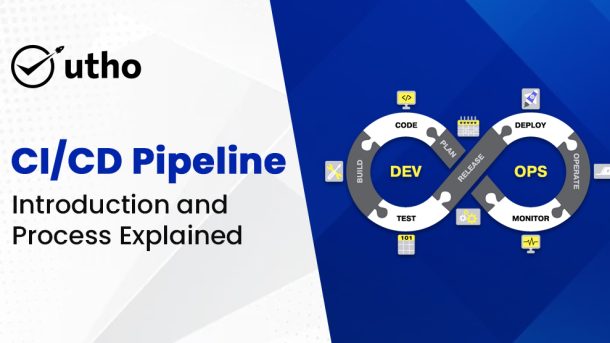In today's fast-paced digital world, speed, efficiency, and reliability are key. Enter the CI/CD pipeline, a software game changer. But what is it exactly, and why should it matter to you? Imagine a well-oiled machine that continuously delivers error-free software updates—the heart of a CI/CD pipeline.
CI/CD is a deployment strategy. It helps software teams to streamline their processes and deliver high-quality apps quickly. This method is the key to success for leading tech companies. It aids them in maintaining a competitive edge in a challenging market landscape.
Want to know how the CI/CD pipeline can change your software development path? Join us to explore continuous integration and deployment. Learn how this tool can transform your work.
What is CI/CD?
CI/CD are vital practices in modern software development. In CI, developers often integrate their code changes into a shared repository. Each integration is automatically tested and verified, ensuring high-quality code and early error detection. CD goes further by automating the delivery of these tested code changes. It sends them to predefined environments to ensure smooth and reliable updates. This automated process builds, tests, and deploys software. It lets teams release software faster and more reliably. It makes CI/CD a cornerstone of DevOps.
The CI/CD pipeline compiles code changes. These changes are made by developers and packaged into software artifacts. Automated testing ensures software is sound and works. Automated deployment services make it available to end users right away. The goal is to find errors in time. This will raise productivity and shorten removal cycles.
This process is different from traditional software development. In that process, several small updates are combined into a large release. The release is tested a lot before it is deployed. CI/CD pipelines support agile development. They enable small, iterative updates.
What is a CI/CD pipeline?
The CI/CD pipeline manages all processes related to Continuous Integration (CI) and Continuous Delivery (CD).
Continuous Integration (CI) is a practice in which developers make frequent small code changes, often several times a day. Each change is automatically built and tested before being merged into the public repository. The main purpose of CI is to provide immediate feedback so that any errors in the code base are identified and fixed quickly. This reduces the time and effort required to solve integration problems and continuously improves software quality.
Continuous Delivery (CD) extends CI principles by automatically deploying any code changes to a QA or production environment after the build phase. This ensures that new changes reach customers quickly and reliably. CD helps automate the deployment process, minimize production errors, and accelerate software release cycles.
In short, the CI portion of the CI/CD pipeline includes the source code, build, and test phases of the software delivery lifecycle, while the CD portion includes the delivery and deployment phases.
The Core Purpose of CI/CD Pipelines
Time is crucial in today's fast-paced digital world. Fast and efficient software development, testing and deployment are essential to remain competitive. This is where the CI/CD pipeline comes in. It is a powerful tool. It automates and simplifies software development and deployment.
CI/CD stands for Continuous Integration and Continuous Deployment. It combines Continuous Integration, Continuous Delivery, and Continuous Deployment into a seamless workflow. The main goal of the CI/CD pipeline is to help developers. They use it to continuously add code changes, run automated tests, and send software to production. They do this reliably and efficiently.
Continuous Integration: The Foundation for Smooth Workflow
Continuous Integration (CI) is the first step in the CI/CD pipeline. This requires often adding code changes from many developers. We add them to a shared repository. This helps to find and fix conflicts or errors early. It avoids the buildup of integration problems and delays.
CI allows developers to work on different features or bug fixes at the same time. They know that the changes they make will be systematically merged and tested. This approach promotes transparency, collaboration, and code quality. It ensures that software stays stable and functional during development.
Continuous Development: Ensuring rapid delivery of software
After code changes have been integrated and tested with CI, the next step is Continuous Delivery (CD). This step automates the deployment of software to production. It makes the software readily available to end users.
Continuous deployment ends the need for manual intervention. It reduces the risk of human error and ensures fast, reliable software delivery. Automating deployment lets developers quickly respond to market demands. They can deploy new features and deliver bug fixes fast.
Test Automation: Backbone of QA
Automation is a key element of the CI/CD pipeline, especially in testing. Automated testing lets developers quickly test their code changes. It ensures that the software meets quality standards and is bug-free.
Automating tests helps developers find bugs early. It makes it easier to fix problems before they affect users. This proactive approach to quality assurance saves time and effort. It also cuts the risk of critical issues in production.
Continuous Feedback and Improvement: Iterative Development at its best
The CI/CD pipeline fosters a culture of continuous improvement. It does this by giving developers valuable feedback on code changes. Adding automated testing and deployment lets developers get quick feedback. They can see the quality and functionality of their code. Then, they can make the needed changes and improvements in real-time.
This iterative approach to development promotes flexibility and responsiveness. It lets developers deliver better software in less time. It also encourages teamwork and knowledge sharing. Team members can learn from each other's code and use best practices to improve.
Overall, the CI/CD pipeline speeds up software development and deployment. It automates and simplifies the whole process. This lets developers integrate code changes, run tests, and deploy software quickly and reliably. The CI/CD pipeline enables teams to deliver quality software. It does so through continuous integration, continuous deployment, automated testing, and iterative development.
The Advantages of Implementing a Robust CI/CD Pipeline
In fast software development, a good CI/CD pipeline speeds up and improves quality and agility. Organizations strive to optimize their processes. Implementing a CI/CD pipeline is essential to achieving these goals.
Increasing Speed: Improving Workflow Efficiency Time is critical in software development. Competition is intense. Customer demands are changing. Developers need to speed up their work without cutting quality. This is where the CI/CD pipeline shines. It helps teams speed up their development.
Continuous Integration: Continuous Integration (CI) is the foundation of this pipeline. This allows teams to seamlessly integrate code changes into a central repository. By automating code integration, developers can work together well. They can also find problems early, avoiding the "integration hell" of traditional practices. Each code change improves development. It makes the process smoother and faster. This helps developers quickly solve problems and speed up their work in real-time.
Quality Control: Strengthening the Software Foundation
Quality is crucial to success. However, it's hard to maintain in a changing environment. A robust CI/CD pipeline includes several mechanisms to ensure high software quality.
Continuous testing: Continuous testing is an integral part of the CI/CD pipeline. This allows developers to automatically test code changes at each stage of development. This method finds and fixes problems early. It reduces the risk of errors and vulnerabilities. Automated testing lets developers release software with confidence. The test safety net finds differences.
Quality Gates and Guidelines: Quality portals and guidelines promote accountability and transparency. Teams must follow best practices and strict guidelines. They will do so by meeting standard quality gates. This will cut technical debt and improve the final product's quality.
Improve Agility: Adapt quickly to change. In a constantly changing world, adaptability is essential. A CI/CD pipeline lets organizations embrace change. They can also adapt to fast-changing market demands.
Easy deployment: Continuous delivery automates the release process. It makes deploying software changes to production easy for teams. This reduces the time and effort needed to add new features and fix bugs. It speeds up the time to market. It lets you quickly respond to customer feedback and market changes.
Iterative improvement: Iterative improvement fosters a culture of continuous improvement. Each development iteration provides valuable information and insights to optimize the workflow and improve the software. An iterative approach and feedback loops help teams innovate. They also help them adapt and evolve. This ensures their software stays ahead of the competition.
Key Stages of A CI/CD Pipeline
Code Integration
Laying the Foundation The CI/CD pipeline journey begins with code integration. In this initial phase, developers commit their code to the shared repository. This ensures that all team members work together well. Their codes integrate smoothly and without conflicts.
Automatic Compilation
Convert the code into executables once the code is integrated, the automatic build phase begins. This is where the code is compiled into executable form. Automating this process keeps the code base deployable. It reduces the risk of human error and increases efficiency.
Automated Testing
Quality and Functionality Assurance The third step is automated testing. The code undergoes many tests. They make sure it works and meets quality standards. This includes unit testing, integration testing, and performance testing. All issues are identified and resolved, ensuring code robustness and reliability.
Deployment
Product Release Once the code has passed all the tests, it moves to the deployment phase. This step involves publishing the code to production. This makes it available to end users. Automatic deployment ensures a smooth and fast transition from development to production.
Monitoring and Feedback
Collection of knowledge after implementation the monitoring and feedback begins. Teams watch the application in production, collecting user feedback and performance data. This information is invaluable for continuous improvement.
Rollback and Recovery
When problems occur in production, the Rollback Phase lets teams revert to an older app version. This ensures that problems are fixed fast. It keeps the app stable and users happy.
Continuous Delivery
It keeps the CI/CD pipeline moving. This phase focuses on the continuous delivery of updates and improvements. It fosters a culture of ongoing improvement, teamwork, and innovation. This ensures that software stays current and meets user needs.
Optimizing Your CI/CD Pipeline
Creating a reliable and efficient CI/CD pipeline is now essential. It's crucial for organizations. They want to stay competitive in the ever-changing software world. Agile methods and modern programming make it easy to deliver cutting-edge software. A good CI/CD pipeline does this. It does this with little effort and great efficiency. We'll explore the best tips and tricks for setting up, managing and developing CI/CD pipelines.
Enabling Automation: Streamlining Your Workflow
Automation is the backbone of a robust CI/CD pipeline. Automating tasks like building, testing, and deploying code changes saves time. It also cuts errors and ensures consistent software. Automated builds triggered by code commits quickly find integration issues. Automated tests then give instant feedback on code quality. Deployment automation ensures fast, reliable releases. It also reduces downtime risk and ensures a seamless user experience.
Prioritizing Version Control: Promoting Collaboration
Version control is essential in any CI/CD pipeline. Git is a reliable version control system. Teams can use it to manage code changes, track progress, and collaborate well. With version control, developers always work on the latest code. It's easy to roll back if problems arise. A data warehouse is a single source of truth for the whole team. It promotes transparency and accountability.
Containers: Ensure consistency and portability
Containers, especially with tools like Docker, have revolutionized software development. Teams do this by packaging apps and dependencies into small, portable containers. This ensures builds are consistent and repeatable across environments. Storage also enables scalability and efficient resource use. It allows easy scaling based on demand. Containers allow teams to deploy applications anywhere. They work from local development to production servers, without compatibility issues.
Enable Continuous Testing: Maintain Code Quality
Adding automated testing to your CI/CD pipeline is critical. It improves code quality and reliability. Automated tests catch errors early. They include unit, integration, and end-to-end tests. They give quick feedback on code changes. Testing helps avoid regressions. It lets the team deliver stable software fast.
Continuous monitoring: Stay Ahead of Issues
Continuous monitoring is key to CI/CD pipeline development. Robust monitoring and alerting systems help find and fix issues in production. They do so proactively. Tracking metrics shows how well your app is performing. These metrics include response times and error rates. It also shows how healthy it is. Integration with registry management enables efficient troubleshooting and analysis. Continuous monitoring ensures a smooth user experience and minimizes downtime.
It can speed up software development. How? By adding automation and version control to your CI/CD pipeline. It can deliver high-quality applications and quickly respond to market changes. This is achieved by also adding isolation, continuous testing, and continuous monitoring. These best practices can help your software team drive innovation. They can also drive business success in today's fast-tech world.
Unleash your potential with Utho
Utho is not just a CI/CD platform; it acts as a powerful catalyst to maximize the potential of cloud and Kubernetes investments. Utho provides a full solution for modern software. It automates build and test processes. It makes cloud and Kubernetes deployments simpler. It empowers engineering teams.
With Utho, you can simplify your CI/CD pipeline. It will increase productivity and drive innovation. This will keep your organization ahead in the digital landscape.




